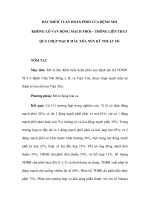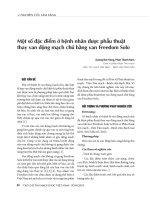Đóng thông liên thất loại không có gờ động mạch chủ bằng dụng cụ ADO II
Bạn đang xem bản rút gọn của tài liệu. Xem và tải ngay bản đầy đủ của tài liệu tại đây (2.13 MB, 39 trang )
Transcatheter closure of VSD
deficient aortic rim
using ADO II device
Nguyen Van Hieu
Nguyen Lan Hieu
Vietnam Heart Institue
Outline
VSD deficient aortic rim
Can VSD deficient aortic rim be
closed by device ?
How to use ADO II device to
close VSD deficient aortic rim?
Our study results
VSD deficient aortic rim
What is VSD deficient
aortic rim?
How about treatment ?
Ventricular septal defect (VSD)
1
2
3
4
VSD deficient aortic rim
Perimembranous
VSD without
aortic rim
Subarterial VSD
illustration of VSD deficient aortic rim
Subarterial VSD
Perimembranous VSD
without aortic rim
Risk AR of VSD deficient aortic rim
AR
Natural history of subarterial VSD
Study: 214 pts
1. 73% of 139 asymptomatic pts develop AVP
2. 80% of pts with AVP develop AR
3. AVP and AR:
– 1 year: 8%
– 5 years: 30%
– 10 years: 64%
– 15 years: 83%
Lun K, Li H, Leung MP et al; Am J Cardiol 2001; 87(11): 1266-1270
Which choice for treatment ?
Intervention VSD deficient aortic rim
Surgical closure
• Traditional method
• Preferred in most
centers
• Indication for multiple
VSDs or VSD associated
anomalies
Transcatheter closure
• No guideline
• Complications are
aortic regurgitation
and arrhythmia
• The most sophisticated
and challenged
procedure.
European heart journal 2010; doi:10.2093/eurhearj/ehq249
Can we close VSD deficient aortic rim by device ?
Study in Thailand (2011)
Study:
• 116 pts. (83 perim VSD, 36 Doubly committed VSD)
• Age: 1 - 29 yrs
Results:
•
•
•
•
Successfully implanted in 94%
Small residual shunt: 12/16 (18.2%)
Moderate and large AR at 6 months: 0/33 (0%)
Complete heart block 6 cases (5.2%)
Chungsomprasong P; Kritvikrom Durongpisitkul et al; Catheter
Cardiovasc Interv. 2011 Dec 1; 78(7):1032-40
In Vietnam (2013)
Do Nguyen Tin et al : 65 cases infundibular VSD
Results:
• Successful 61 cases (94%)
• Hemolysis 2 cases: Due to residual shunt
• Technical failure 2 cases: The devices were not stable
due to:
– Underestimated the sizes of defects
– The device configuration was changed
Systematic Review (2014)
• 37 studies, 4,406 pts with VSD ( pm 3,758; doubly
committed subarterial 36), Age: 3 days to 84 years
• Results:
– Successful device implantation: 96.6%
– Most complication are residual shunt 25.5 %,
valvular defects 4.9% and arrhythmias 10.6%
– Similar to surgery results
Linqi Yang et al; Journal of Interventional Cardiology Vol. 27, No. 3, 2014
In China (2015)
Study:
• 86 patients with doubly committed subarterial VSD
• Age 7.0 ± 7.0 years, VSD size 4.8 ± 1.5 mm
• Follow up: 4.5 ± 1.5 years
Results:
• Successfully done in 75 patients (87.2 %) -> 94.7 % at
discharge and 96 % during follow-up.
• No severe complications
• Trivial-mild grade aortic valve regurgitation (AR): 16
(21.3 %)
• Failure: 11 patients
Zhanget; Da Zhu et al. Journal of Cardiothoracic Surgery (2015) 10:119
It means…
We can close
VSD deficient
aortic rim by
device!
How to use ADO II device to close VSD
deficient aortic rim?
Amplatzer duct occluder (ADO) II
device
Theory: The pm VSD form look like type A of PDA
(Kritchenco classify) : like anatomy and physiology
Using PDA device for VSD closure is reasonable !
ADO II - Advantages
• Softer (No polyester patch)
• Designed for flexibility
• Retention disc: Raise aortic
valve
• Small delivery system
• CHB has not been reported
• Ease of deployment
ADO II - Limitations
• Close VSDs only up to 5 – 5.5 mm
• Encroachment on the aortic valve and
LVOT
• Impairment of TV mechanism
Instruments
• Crossing catheter (soft tip)
– JR 3.5; 4
– IMA
– Cut Pigtail
•
•
•
•
Terumo exchange guide wire
Snare
Delivery catheter : 4 – 5 Fr
TOE or TTE.









